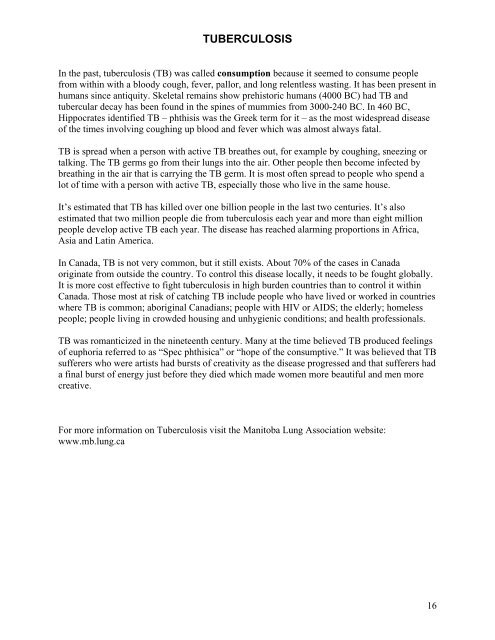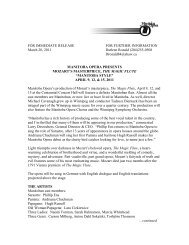La Traviata Study Guide - Manitoba Opera
La Traviata Study Guide - Manitoba Opera
La Traviata Study Guide - Manitoba Opera
You also want an ePaper? Increase the reach of your titles
YUMPU automatically turns print PDFs into web optimized ePapers that Google loves.
TUBERCULOSIS<br />
In the past, tuberculosis (TB) was called consumption because it seemed to consume people<br />
from within with a bloody cough, fever, pallor, and long relentless wasting. It has been present in<br />
humans since antiquity. Skeletal remains show prehistoric humans (4000 BC) had TB and<br />
tubercular decay has been found in the spines of mummies from 3000-240 BC. In 460 BC,<br />
Hippocrates identified TB – phthisis was the Greek term for it – as the most widespread disease<br />
of the times involving coughing up blood and fever which was almost always fatal.<br />
TB is spread when a person with active TB breathes out, for example by coughing, sneezing or<br />
talking. The TB germs go from their lungs into the air. Other people then become infected by<br />
breathing in the air that is carrying the TB germ. It is most often spread to people who spend a<br />
lot of time with a person with active TB, especially those who live in the same house.<br />
It’s estimated that TB has killed over one billion people in the last two centuries. It’s also<br />
estimated that two million people die from tuberculosis each year and more than eight million<br />
people develop active TB each year. The disease has reached alarming proportions in Africa,<br />
Asia and <strong>La</strong>tin America.<br />
In Canada, TB is not very common, but it still exists. About 70% of the cases in Canada<br />
originate from outside the country. To control this disease locally, it needs to be fought globally.<br />
It is more cost effective to fight tuberculosis in high burden countries than to control it within<br />
Canada. Those most at risk of catching TB include people who have lived or worked in countries<br />
where TB is common; aboriginal Canadians; people with HIV or AIDS; the elderly; homeless<br />
people; people living in crowded housing and unhygienic conditions; and health professionals.<br />
TB was romanticized in the nineteenth century. Many at the time believed TB produced feelings<br />
of euphoria referred to as “Spec phthisica” or “hope of the consumptive.” It was believed that TB<br />
sufferers who were artists had bursts of creativity as the disease progressed and that sufferers had<br />
a final burst of energy just before they died which made women more beautiful and men more<br />
creative.<br />
For more information on Tuberculosis visit the <strong>Manitoba</strong> Lung Association website:<br />
www.mb.lung.ca<br />
16








